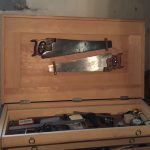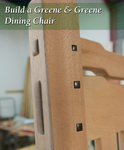We may receive a commission when you use our affiliate links. However, this does not impact our recommendations.
 After decades working in corporate America, George R. Walker’s woodworking took a huge detour while doing research for an article on pre-industrial design. Since that time, George has explored design in numerous writings, including “By Hand & Eye” and “By Hound & Eye,” books co-written with Jim Tolpin (Lost Art Press). His videos include “Unlocking the Secrets of Traditional Design” and “Unlocking the Secrets of Traditional Design: Mouldings” (Lie-Nielsen Toolworks). George is the Design Matters columnist for Popular Woodworking Magazine and hosts a furniture design blog of the same name. George took a few minutes to speak with us about his ideas, work and upcoming appearance at Woodworking America.
After decades working in corporate America, George R. Walker’s woodworking took a huge detour while doing research for an article on pre-industrial design. Since that time, George has explored design in numerous writings, including “By Hand & Eye” and “By Hound & Eye,” books co-written with Jim Tolpin (Lost Art Press). His videos include “Unlocking the Secrets of Traditional Design” and “Unlocking the Secrets of Traditional Design: Mouldings” (Lie-Nielsen Toolworks). George is the Design Matters columnist for Popular Woodworking Magazine and hosts a furniture design blog of the same name. George took a few minutes to speak with us about his ideas, work and upcoming appearance at Woodworking America.
PW: Design, it’s safe to say, is the main idea guiding your work. What does the term mean to you, and why is it so important?
GW: Design is really about “seeing”. By that I mean the ability to visualize a project clearly in your mind’s eye. Without that, you are just stumbling about in the dark. Thankfully this is a skill that can be learned. Design is important because it can be the most satisfying part of the craft, but also on a practical level we all have times when we need to modify someone else’s design without butchering it. So even woodworkers who primarily work from plans will find these skills helpful.
It was after working in a factory for twenty years that you discovered the language of design, correct? How did this enlightenment occur? Was it an “ah-ha moment” or more a gradual awakening?
It was a series of ah-ha moments, but I can describe a few. While doing research about pre-industrial design I realized that our ancestors who built furniture in small shops didn’t avail themselves to plans or blueprints as we know them today. This was mind-blowing to me, coming from a background in industry where everything was prescribed in a plan. Another huge revelation was learning that our ancestors used a design language based on simple proportions that were linked to music, nature and the structure in our own bodies. How cool it that!
You’re giving a presentation on how to stop measuring and use the proportions of your body to establish design principles. How is this possible?
One of the best things about proportions is that they are easy to visualize once you become familiar with how they work. Conversely, measurements are useful if you want to mass-produce something, but they don’t give our imagination the same foothold to experiment and play. Since most furniture is designed to be used by humans, all our designs begin with the important parts linked to the human form – i.e., chair heights, table heights, etc.
If proportions are the language of ancient artisans, why are so many people tied to measuring tools today? Did we lose something?
Yes we lost something. The industrial revolution brought about huge changes in the ways artisans worked. Instead of a journeyman designing and building from ideas they could create themselves, industrial workers over time became tied to machines, which required numbers to be fed into them from blueprints coming from a design department. Designer and maker became separated and the link that allowed them to function was modern measuring tools.
You’re a big fan of dividers. I’m a fairly new woodworker and don’t have a pair yet. Convince me to invest in some dividers instead of a fancy, new tape measure.
It’s not an either/or proposition. I would however recommend putting aside the tape measure and begin working with dividers if you really want to develop your design sense. I still use a tape measure for home improvement projects or to figure out if I can fit the grandson’s sandbox in the bed of my pickup. Surprisingly, though, for many quick measurements I know that my open hand span is about 9”, so two hand spans are 18”. Quite a handy thing to know when I’m digging through boards at the lumber yard.
You use the term “intuition” in the presentation title. Do you believe an innate sense of proportions is within us all, waiting to be discovered? And are the skills equally applicable to, say, an Arts & Crafts chair or mid-century cabinet as the more obvious classical designs?
By intuition I mean our innate “gut” sense of when something looks pleasing – or not. Most of us have that in spades. What few possess is the ability to point out why a design succeeds or fails. We all have a strong inner sense of proportions, most notably in the way we perceive beauty in the bodies of other human beings. It’s part of our DNA. We can tap into that inner sense, and it does apply to any style one can imagine. We’re talking about a timeless reality here that’s not tied to a style or era.
Can you appreciate a meticulously-measured example of furniture design?
I can appreciate the drafting skill that goes into making a well-rendered drawing. At the same time, a person can know every minute, measurable detail in a masterpiece and still not have a clue what makes it great. One analogy is an acoustic engineer who can explain with precision the succession of sound waves inside a piece of music, but who is not be able to explain the melody that lifts our spirits.
What are you currently working on?
I’m currently filming and editing an online design instructional course along with Jim Tolpin for our website, byhandandeye.com
I don’t have any big woodworking projects on the bench at the moment, and for quite a while I used to feel a bit of guilt when my writing and research kept me away from the bench. I’ve happily come to realize that Tolpin and I are now playing a part in thousands of woodworking projects carried out by our readers across the entire globe. That thought cheers me up when I’d rather make sawdust than read dusty books. I do however have a huge list of projects I want to explore, and another my dear wife wants completed. Anyone have any advice about that dilemma?
Don’t miss George Walker at Woodworking in America, September 16-18. Click to learn more about WIA.
Here are some supplies and tools we find essential in our everyday work around the shop. We may receive a commission from sales referred by our links; however, we have carefully selected these products for their usefulness and quality.









